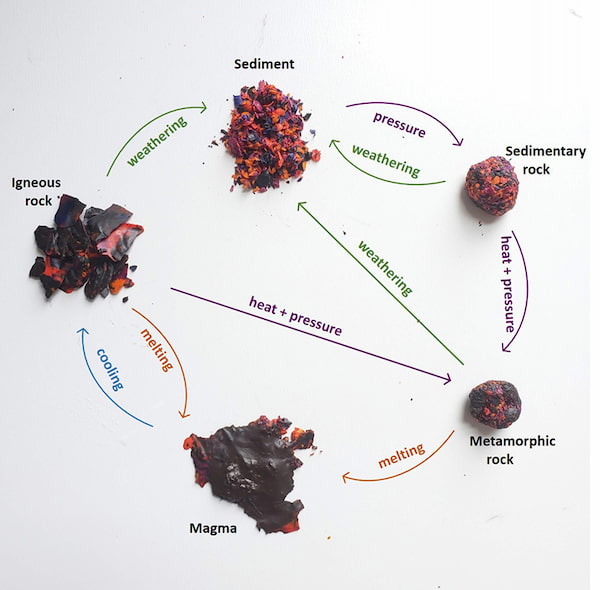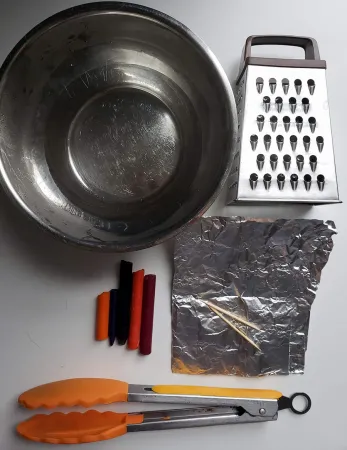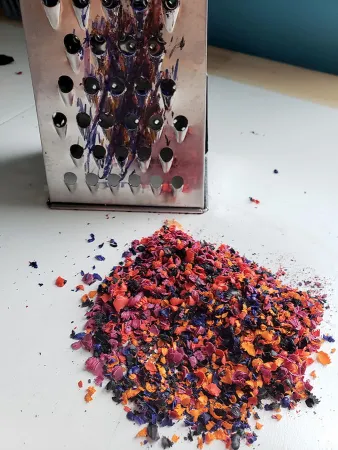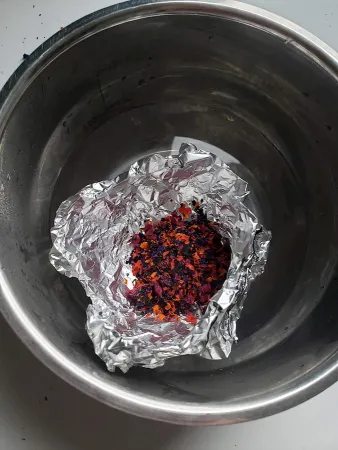
It can be hard to imagine the rock cycle in action — after all, it takes millions of years for it to complete! However, it doesn’t take nearly as long for crayons to do the same thing. Take a look at how crayons react to how the Earth molds the world’s rocks.
What you need
- Crayons
- Very hot or boiling water
- Heat-resistant bowl
- Aluminum foil
- Grater
- Tongs
- Tooth pick
- Optional: bowl with icy water
Safety first!
Adult supervision may be needed when handling a grater and boiling water.
Make it
- Your new crayons start off representing new igneous rocks. Remove any paper packaging, and use the grater to form small shavings. These represent the sediments.
- Mash the sediments together in your hands to form a solid. This represents a sedimentary rock.
- Make a small cup out of foil, and fill it with these shavings.
- Fill the bowl with your hot water. Get adult help if needed.
- Float the cup on top of the hot water for a few minutes, until the shavings are joining together and the mixture is soft when you touch it with the toothpick. Remove it with the tongs. Let it cool and harden to form your metamorphic rock.
- Place your cup back on top of the hot water. This time, allow it to completely melt into a liquid, which represents the magma. Remove it with tongs. Let it cool and harden to form your igneous rock.
Test it
You can repeat the cycle once more, now that you have regenerated your igneous rock. Or instead, do the cycle backward — see if you can go from igneous to metamorphic and then to sedimentary.
Explain it
There are three types of rock: igneous, sedimentary, and metamorphic.
- Igneous rocks are formed from cooled magma, which is a liquid made of melted minerals. Magma is known by another more familiar name when it is found above ground: lava.
- Sedimentary rocks are formed when sediments, or fine particles (just like the crayon shavings), are packed together tightly without the addition of any heat. Sediments are formed by weathering and erosion, which essentially means something like the weather destroys or moves it over time.
- Metamorphic rocks are formed when heat and pressure are applied to rocks, which change their chemical structure in the process.
The Earth catalyzes all of these reactions naturally. Through natural weathering processes like ocean waves, sediments are eroded from igneous and metamorphic rocks so that sedimentary rocks can be formed. The immense heat and pressure needed to make metamorphic rocks comes from deep under the Earth’s outer layer, the crust. The conditions required to completely liquefy minerals into magma occurs mostly near the top of the asthenosphere layer of the Earth.

Observe it
Although the rock cycle can take millions of years to complete, you can see its results in the rocks you collect outside! Use resources online to identify rocks that you’ve collected, and pay close attention to which kind of rocks they are. Do you see any external characteristics in common?
Go further
When cooling your igneous crayon rock, instead of leaving it out to cool naturally, plunge it into a bowl of ice water. What happens?
Real igneous rocks can either cool deep within the Earth, or near the surface of the crust. Just like when you left your crayon rock to cool on the table, when rocks cool inside the Earth, it is much hotter. This means that the crystals that form in the rock are much bigger, and the rock is called intrusive. In contrast, just like plunging it in the cold ice water, igneous rocks can cool near the colder surface of the Earth. The crystals are formed much quicker, so they are much smaller. These rocks are called extrusive.
Program Details
- View all programs at the Canada Science and Technology Museum
- View other programs related to Earth & Environment



